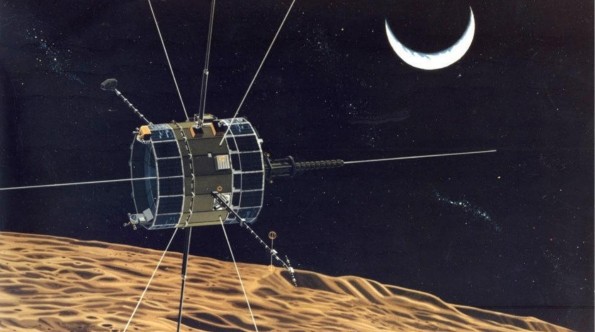From The Economist
"WE JUST made contact. I need to talk to you in 30 minutes," says Keith Cowing, the editor of NASA Watch, an online publication. Just as Babbage called him, Mr Cowing received word from the Arecibo Observatory in Puerto Rico that his colleagues had made contactwith a NASA satellite launched in August 1978. When your correspondent called back, Mr Cowing was irrepressible: the satellite had responded to commands and was now set into "coherent ranging mode", which should make it easier to talk to it. The group had captured the satellite.
This was no act of space piracy. Mr Cowing, Dennis Wingo of Skycorp and several other experts had received permission from NASA to take control of a satellite for which the space agency has no further purpose nor funding. With the help of nearly $160,000, raised through crowdfunding, the team hopes to start a new mission and release the raw data that emerge.
The International Solar-Environment Explorer (ISEE-3, see picture) completed its initial mission close to the sun, where it took measurements of solar properties, and was repurposed in 1983 to hunt comets as the International Cometary Explorer (ICE). During its second lease on life it intercepted comet Giacobini-Zinner in 1985 and then transited between the sun and Halley in 1986. This repurposing involved a series of intricate flybys of the Earth and the moon to slingshot the satellite into its comet-tracking trajectory. NASA shut down the mission in 1997, although occasionally checked in on the bird's status.
Before they turned off the light, Robert Farquhar, the mission's flight-dynamics manager, and his team used the satellite's propulsion system to set it on a course that 28 years after its final scientific measurements in 1986 would bring it close to Earth. The rendezvous is rapidly approaching. Dr Farquhar is now part of the ISEE-3 Reboot Project to re-establish contact. Mr Cowing says participants range in age from their 20s to their 80s, and include ex-NASA employees like himself as well as a current one who works on the project in his spare time.
Although the ISEE-3 was launched a year later than the Voyager 1 and 2 probes, its computers are much less powerful. The Voyagers had redundant sets of three separate computers and could store and execute programs, as well as radiological power sources. ISEE-3 can be triggered through radio commands to execute sequences of actions, but it cannot be put into an autonomous mode. Its batteries failed 20 years ago, and it is now entirely dependent on solar power.
It appears to have survived unscathed the long occupancy of the orbit in which it was parked. However, celestial mechanics have put the satellite about 250,000km off from where it was expected. Mr Cowing and his colleagues are slightly worried that it may bash into the moon or wander too close to Earth. The craft has antennas measuring 30 metres and extending in four directions, which at a certain altitude above Earth could cause problems. "It's a 360-foot spinning cookie cutter," says Mr Cowing.
That the reboot project has got that far is remarkable. Unable to receive a clear go-ahead or an outright no from NASA a few months ago, it set out to raise funds hoping that this might prompt the space agency to acquiesce. It is the first time in NASA's history that operational control has been handed over, and NASA made the announcement on May 23rd with due fanfare.
With the original software, computers or telecoms gear long gone, the team—with the help of some original mission members and others in and out of NASA who knew where to find the old manuals—recreated the equipment, including a software-defined radio system that allows talking and listening to the satellite. The Arecibo Observatory also provided help: it installed gear purchased by the Reboot Project and allowed it to use Arecibo's huge satellite dish free during downtimes. The team faced downpours of rain and even an earthquake with a magnitude of 5.8 while one of the volunteers worked near the dish.
Much remains to be determined. Mr Cowing and his colleagues have yet to decide whether the satellite is to explore more comets or to use it for other purposes. Just as both Voyager probes remain active and Voyager 1's ancient instruments in 2013 produced measurements that upended some long-held notions about interstellar magnetic fields, the group expects that its craft can provide data worth examining. The team will soon give up its big "ear" at Arecibo and decamp to Morehead State University in Kentucky: the initial capture and the repositioning allow the use of the smaller dish there.
This initial contact indicates that the satellite's computer and radios are functioning. The next steps are to determine more fully whether its control systems work as expected and test its instrumentation and propulsion. The team must fire its rockets by mid-June to reposition ISEE-3. The next big challenge will come when the satellite swings around the moon onto its shadowed side and is cut off from the sun. The craft will power down for the first time in many years, and the team hopes when it sees it again, it will wake up and resume communications. It has lasted this long, and the group hopes for many more years to come. "This thing has had a second act, and we're giving it its third," says Mr Cowing.

